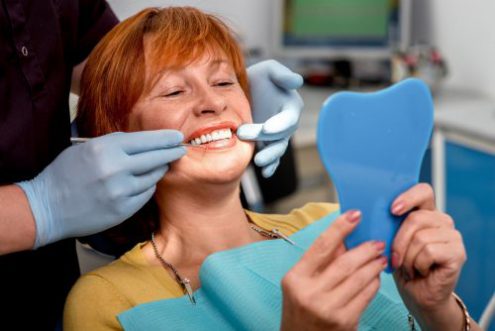About 50,000 people a year are diagnosed with oral cancer in the United States each year, and about 10,000 will die from the disease.
Early detection and diagnosis are the most factors in successfully treating oral cancer, which may occur on the lip, inside the mouth, tonsils, salivary glands, esophagus, back of the throat, tongue, and soft tissues of the mouth. For most people, anything mentioning the word cancer is automatically intimidating, but it’s essential not to let that stop you from being examined frequently.
Dentists and periodontists like the people on our team at Farber Center are qualified and ready to perform oral cancer screenings for our patients. It’s a relatively quick and straightforward process that can occur as part of a routine check-up, often along with a dental or periodontal cleaning appointment. Of course, if you notice a suspicious bump or other abnormality in your mouth, don’t wait and make sure to schedule an appointment immediately. It’s vitally important to be checked out by a professional promptly if you suspect something may be wrong.
Risk Factors for Oral Cancer
Leading health care institutions, such as the Mayo Clinic list several factors that can increase your risk of mouth cancer. They include:
- Tobacco use of any kind: cigarettes, cigars, pipes, chewing tobacco, snuff
- Heavy alcohol consumption
- Excessive sun exposure to your lips
- The human papillomavirus (HPV)
- A weakened immune system
Avoiding the risk factors that are within your control will certainly help. But it’s essential to keep in mind that as many as 30-percent of people diagnosed with oral cancer do not have any of the risk factors.
Symptoms of Oral Cancer
Changes in the seasons can be times when many of us develop colds, and a few of the symptoms associated with oral cancer are similar to symptoms of a cold. Therefore, be sure to keep track of when they start. If the symptoms last longer than two weeks, however, we recommend visiting Farber Center for an exam.
- A sore throat
- Difficult or painful swallowing
- Difficult or painful chewing
- Jaw pain or stiffness
- Tongue pain
- Poorly fitting dentures
- Loose teeth
- A growth, lump or thickening of the skin or lining of your mouth
- A sore that doesn’t heal
- A sore that bleeds
The Oral Cancer Screening Process
Typically, oral cancer screenings are two-part. There is a visual exam and a physical exam.
 Visual Exam:
Visual Exam:
In the visual exam, we will inspect your face, neck, lips, inside of the nose, and oral cavity. You will need to take out removable dental appliances to expose all areas inside your mouth. We then will check for asymmetries, swelling, bumps, patches of color, ulcerations, or any other abnormality.
Physical Exam:
During or after the visual exam, we will check your head, cheeks, jaw, under the chin, and oral cavity for unusual masses. Difficulty opening your mouth or pain while being checked for masses may also be signs of oral cancer.
After Your Initial Oral Cancer Screening
The oral cancer screening process is typically precautionary and not diagnostic; therefore, if something is abnormal, you will be asked to come in for more regular screenings as a precautionary measure. The exams are not complicated, and early diagnosis is your best method to combat oral cancer.
Oral cancer screenings have value beyond the exam itself. They give you a chance to talk to your periodontist or dentists about any concerns — and to learn more about reducing oral cancer risks. If you’re apprehensive about having a screening, considering writing a list of questions before you go, then you will remember to ask about everything on your mind. Once the exam is complete, it can help to put your mind at ease.
Farber Center for Periodontics & Dental Implants offers oral cancer screenings at our Hauppauge and Medford, NY, dentist offices, and we encourage you to schedule an appointment today.
Call us with any questions or to make an appointment.
Comments are closed.
